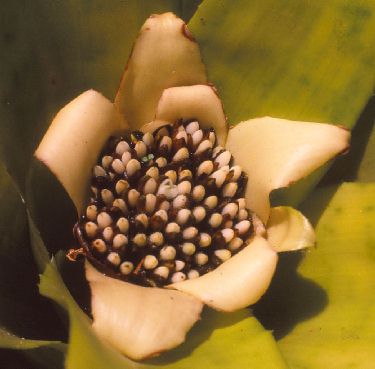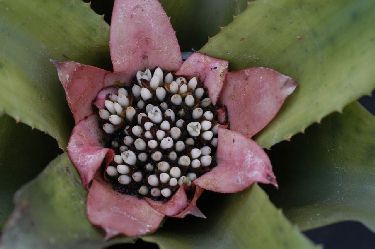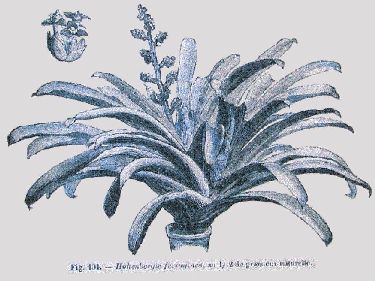

Most Bromeliad growers accepted the new genus Edmundoa proposed by Elton Leme (1997) because it was well presented and was logical. Some, like Kew Gardens {http://apps.kew.org/wcsp/qsearch.do;jsessionid} (checked 26 July 2014) are not convinced.
(Ed. Sydney Botanic Gardens have some labelled Canistrum - and some labelled Edmundoa ! Hedging their bets ?)
When reading Die Bromelie 2:78. 2013 I saw reference to a Canistrum fragrans (Linden) Mabb. which started me asking questions. Thanks to Eric Gouda and Leo Dijkgraaf I was able to obtain the article by D J Mabberley (1990).
To think there was a publication mentioning Bromeliads in 1990 that I had missed!
Most of his changes were simple and have been noted in the New Bromeliad Taxon List http://botu07.bio.uu.nl/bcg/taxonList.php but the one referring to Canistrum fragrans needed some checking. For example no mention was made of Canistrum fragrans (Linden) Mabb. in Canistrum – Bromeliads Atlantic Forest. 46. 1997.
We were able to get a copy of Linden’s actual catalogue 1862 where you could buy Guzmania fragrans for 25 francs. This is just a list with no indication as to what the plant looked like. Further investigation was needed because we had to rely on subsequent writers to possibly identify what plants they referred to. Leo was able to find references by Morren who in Belg. Hort. 29:168 (1879) and in Index Bibliographique (1887) says this is Canistrum eburneum E.Morren. Baker in Handbook (1889) page 69 shows: G. fragrans Hort Linden = Aechmea eburnea Baker.
If we refer to Flora Neotropica (1979) we find; G. fragrans Hort ex Baker = G. monostachia, and G. fragrans Linden Hort ex Regel = Canistrum lindenii. The reference to G. monostachia can be explained because Baker in Handbook (1889:152) under G. tricolor (a synonym of G. monostachia) we find "G. maculata, grandis and fragrans are fine garden varieties". All three are in Linden’s catalogue under Guzmania but we know that when Morren was describing Canistrum roseum in Belgique Horticole 33:195 (1883) in the last sentence Morren says it is deplorable and a gross error in nomenclature that several Canistrum in cultivation are called Guzmania! Regrettably, he did not specify the plants concerned. In the circumstances it does seem reasonable to follow Morren in interpreting Guzmania fragrans as a Canistrum rather than Baker in treating it as a Guzmania. If we follow D J Mabberley (1990), we find Guzmania fragrans LINDEN, Cat. 17: 4 (1862) = Canistrum fragrans (LINDEN) Mabb. comb. nov. (Bromeliaceae). Type (‘clonotype', selected here):Belg. Hort, 29 (1879) t. l3 Syn.: Nidularium lindenii REGEL, Ind. Sem. Hort. Petrop. 1868 (1869) 78. nom. superfl. pro praec. C. lindenii (REGEL) Mez in MART., Fl. Bras. 3. 3 (1891 ) 256.
However, this is not acceptable under the ICN rules (no description and type are provided) according to Eric Gouda and Gea Zilstra of the Utrecht University and Edmundoa lindenii prevails.
References
Baker, J. G. (1889) Handbook of the Bromeliaceae. George Bell & Sons, London UK, 243 pp.
Leme E.M.C. (1997) Canistrum – Bromeliads of the Atlantic Forest. 46.
Mabberley, D.J. (1990) The significance of the three independent ‘Kew’ editions of JOHNSON'S Gardener's Dictionary. Feddes Repertorium 101(5-6): 263–276.


To me, I would really have to stretch my imagination to link it to what we grow as Edmundoa lindenii. As I pointed out in my previous article other botanists around Europe reported on this plant and all had different ideas as to what it was. The closest one seems to be Carriere who, in 1881, likened this to his Hohenbergia ferruginea which is now known as Hohenbergia augusta. Here is a translation of what he said: ‘This species (fig. 104), which probably has never flowered in France, and whose flowering occurred in the greenhouses of the Senate, in Luxembourg, is found in a few collections under the names of Nidularium fragrans or Gusmannia maculata.’
Let me digress here because Hohenbergia augusta was the first Hohenbergia that I flowered some 35 years ago. It was a huge plant with a disappointing inflorescence of a spike with hairy ‘pinecone’ branches and very pale blue flowers.
As a layman I think that Kew was wrong in adopting the species name of ‘fragrans’ to replace Canistrum lindenii. From the botanists point of view I understand that Eric Gouda will be writing an article to conserve the name ‘lindenii’ whether for Edmundoa or Canistrum in some scientific journal which you may not see.
